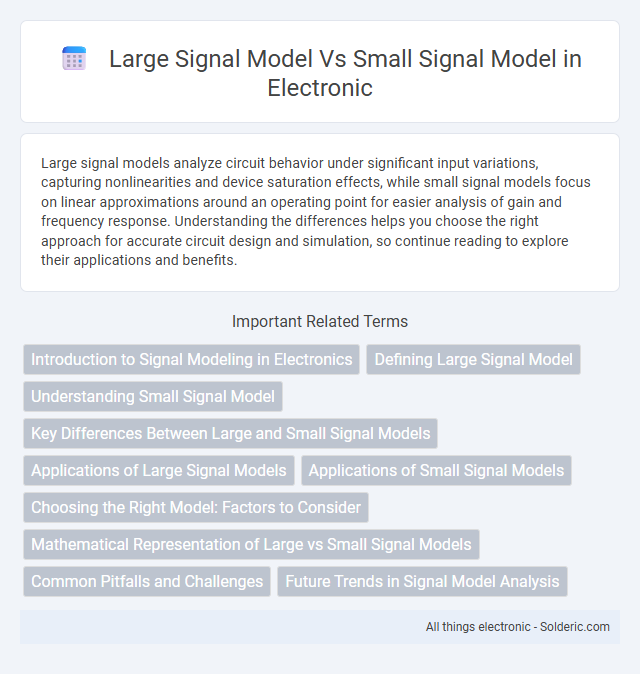Large signal models analyze circuit behavior under significant input variations, capturing nonlinearities and device saturation effects, while small signal models focus on linear approximations around an operating point for easier analysis of gain and frequency response. Understanding the differences helps you choose the right approach for accurate circuit design and simulation, so continue reading to explore their applications and benefits.
Comparison Table
| Aspect | Large Signal Model | Small Signal Model |
|---|---|---|
| Definition | Analyzes device behavior under large input variations, including nonlinearities. | Analyzes device behavior under small input variations, approximated as linear. |
| Purpose | Understand overall device operation and nonlinear response. | Study incremental gain, impedance, and frequency response. |
| Application | Power amplifiers, switching circuits, digital logic. | Amplifier small-signal analysis, AC response, noise analysis. |
| Model Type | Nonlinear equations and full transistor characteristics. | Linearized equivalent circuits around a bias point. |
| Input Signal | Large amplitude, may exceed device linear region. | Small amplitude, limited to linear region near operating point. |
| Complexity | More complex; requires numerical methods or iterative analysis. | Simpler; uses linear circuit analysis techniques. |
| Output | Accurate voltage/current waveforms including distortion. | Approximate small variations, gain, and equivalent parameters. |
Introduction to Signal Modeling in Electronics
Large signal models analyze electronic devices under conditions where input signals cause significant variations in voltage or current, capturing nonlinear behavior essential for power amplifier design and switching circuits. Small signal models approximate device behavior around a specific operating point, linearizing nonlinear components to simplify analysis of gain, input/output impedance, and frequency response in amplifiers. Understanding both models enables accurate circuit design, simulation, and optimization across varying signal amplitudes.
Defining Large Signal Model
Large signal models describe the behavior of electronic components like transistors under substantial variations in voltage or current, capturing nonlinear characteristics and saturation effects. These models are essential for analyzing device performance in power amplifiers, switching circuits, and transient responses where signals exceed the linear region. Understanding the large signal model helps you accurately predict component operation beyond small perturbations around an operating point.
Understanding Small Signal Model
The small signal model simplifies complex electronic circuits by linearizing nonlinear components around a specific operating point, enabling easier analysis of circuit behavior under minor input variations. It effectively captures essential parameters like gain, input, and output impedance without dealing with full nonlinearities of devices such as transistors. This model is crucial for designing amplifiers and feedback systems where signal fluctuations are minimal and precise response characterization is required.
Key Differences Between Large and Small Signal Models
Large signal models analyze electronic devices under conditions where voltage or current variations are significant enough to drive nonlinear behavior, essential for power amplifier design and switching circuits. Small signal models approximate device behavior using linearization around an operating point, facilitating simplified analysis of gain, input/output impedance, and frequency response in low-signal regimes. Key differences lie in linearity assumptions, signal amplitude considerations, and application scope, with large signal models addressing device nonlinearities explicitly and small signal models focusing on linear, incremental responses.
Applications of Large Signal Models
Large signal models are essential for designing and analyzing power amplifiers, oscillators, and switching circuits where devices operate beyond their linear region. They accurately predict nonlinear behaviors, including distortion, harmonic generation, and transistor saturation effects crucial for RF and power electronics applications. These models enable engineers to optimize efficiency, gain, and linearity in high-power and high-frequency device performance.
Applications of Small Signal Models
Small signal models are predominantly used in analyzing electronic circuits where the input signal variations are minimal, such as in amplifier design and feedback loop stability assessments. These models help in predicting the linear behavior of nonlinear devices like transistors within their operating range, enabling precise calculations of gain, input and output impedance. Small signal analysis is essential in RF circuit optimization, signal integrity verification, and noise figure estimation.
Choosing the Right Model: Factors to Consider
Choosing the right model depends on the operating region and signal amplitude in electronic circuit analysis. Large signal models accurately represent nonlinear device behavior under high signal levels, crucial for power amplifiers and switching circuits. Small signal models simplify analysis by linearizing device behavior around a bias point, ideal for low-amplitude signals in amplifier design and frequency response evaluation.
Mathematical Representation of Large vs Small Signal Models
Large signal models use nonlinear equations to represent the behavior of electronic components under significant input variations, capturing the full device characteristics such as diode I-V curves or transistor transfer functions. Small signal models linearize these nonlinear equations around an operating point using derivatives, resulting in simplified equivalent circuits with parameters like small-signal resistance or transconductance. Your choice between large and small signal mathematical representation depends on the signal amplitude and accuracy required for circuit analysis or design.
Common Pitfalls and Challenges
Large signal models often face challenges in accurately capturing nonlinear device behavior under high power or voltage swing conditions, leading to convergence issues during simulation. Small signal models, while effective for analyzing linearized responses around an operating point, struggle with inaccuracies when applied beyond their valid signal amplitude range, causing erroneous gain and phase predictions. Both models can suffer from parameter extraction difficulties, where imprecise or outdated extraction leads to reduced predictability in circuit design performance.
Future Trends in Signal Model Analysis
Future trends in signal model analysis emphasize integration of machine learning algorithms to enhance the accuracy of large signal models under high power conditions and small signal models in low power noisefloor analysis. Advances in quantum computing are expected to revolutionize the computational efficiency of both large signal and small signal simulations, enabling real-time semiconductor device modeling. Enhanced hybrid modeling techniques combining large signal nonlinearities with small signal perturbations will drive innovations in next-generation RF and microwave circuit design.
Large signal model vs Small signal model Infographic

 solderic.com
solderic.com